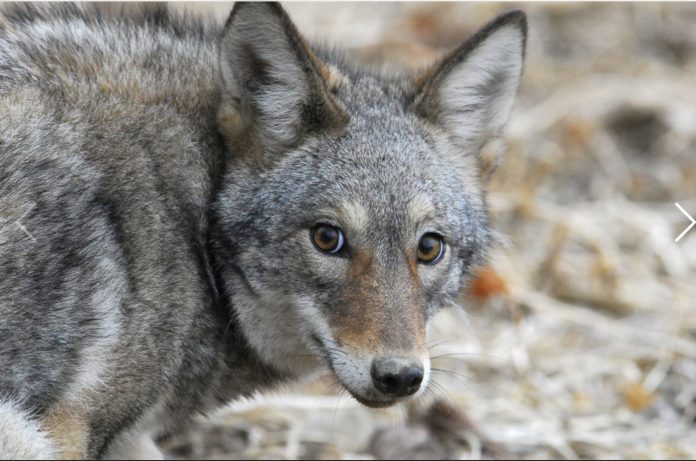
My neighborhood social media page has been all up in arms lately about coyote sightings in the area. Obviously people are worried about their pets and maybe even small children. But are their fears founded and what can be done about population control? (The ‘yotes, not the children.) I decided to do some research and find out.
Although common in the western and plains states for hundreds of years, coyotes (Canis latrans) only made the scene in my state in the 1950’s to 60’s, becoming more common by the 1990’s. Many people still have no experience with them however, and thus the local uproar.
Being members of the same genus as dogs and wolves, coyotes can often be mistaken for one of the other members of its genetic tree when spotted by people with no experience (like me). The only coyotes I have ever seen have been on the game camera I keep at the family property, and even then they have appeared only a handful of times.

But that is a rural wooded property a couple hours north. My house is in a rural-ish development outside of a smallish city. Coyotes have even been heard in town lately, so it should be unsurprising to hear them out here as well. Being generally canny and avoidant of humans, coyote presence is most often recognized by their nighttime calling rather than being actually spotted in the daytime.
Coyote mating season is right about now – mid-January to mid-March. Pups are born about 63 days later, with average litter size running in the 4 to 6 range. Coyotes are said to mate for life. Unlike wolves, which form true packs of multiple adults, coyote “packs” generally consist only of the family unit – two parents and the pups of that season. Though it can sound like more, there are usually only 6 or 7 animals making all those yips and howls in the night.
Non-rural people tend to notice the coyotes more in this, the mating season as their nightly vocalizations increase. But I have also read that the males can be more aggressive during mating season and there can more often be daytime sightings during mating season because of the increased activity and defense of territory.
Eastern coyotes tend to run larger than their western counterparts – in the 30 to 45 pound range. DNA studies of some specimens have found a mixed heritage in the Eastern Coyote, which includes not only true coyotes, but also gray wolf, eastern wolf, and domestic dog genetic material, leading some to call for a separate species designation for this member of the Canis genus.
Coyotes are omnivores – they will eat berries, vegetables, rodents, rabbits, newborn/young wildlife, deer, carrion, pet food left out overnight, and even garbage. The main concern for farmers is livestock predation and the main concern for average citizens is their pets and children. Steps can be taken to minimize the danger to both however.
Lighted corrals/pens and electric fortified fencing are some of the recommendations for farmers to protect livestock especially during lambing and calving season. But electrifying your backyard fence isn’t really an option for kids and pets – though some days it may cross your mind.
Instead game authorities recommend not leaving pet food outdoors, securing garbage, not leaving pets alone outside, keeping pets on a short leash especially during coyote mating season and maybe carrying “a big stick” (their recommendation not mine) while walking your dog in areas frequented by coyotes.
What is being eaten/preyed upon is not the only concern when it comes to coyote populations though. One of the other big concerns is disease.
Coyotes can suffer from Heartworm, Sarcoptic Mange, Rabies, Canine Distemper, Canine Parvovirus, and even in a few rare cases – Tularemia. None of those diseases are things you want your pets or yourself exposed to if you can help it, so limiting contact with coyotes at all is the ideal. Except that human activities mean food to these highly intelligent creatures, so they’re not going to go away voluntarily.
There is some debate whether coyote elimination programs have a positive effect or not. The reason being that hunting and trapping pressure may have the effect of splintering family groups and increasing birth rates. That seems kind of counter productive, but there aren’t a lot of of other options.
In my state there is no closed season on coyotes and no bag limit. You can even hunt them at night during certain stretches of the year. Since coyote hunting is largely a “have at it” affair, it does give a reasonable excuse for those who love their gear and gadgets. Electronic calls? Go for it. Suppressors? Sure. Night vision and thermal imaging? Well yeah. Bag limit? Nah, take as many as you want. But check the local regs for your own area to be sure.
Given the neighborhood concern over hearing ‘yote activity so close I bought a cheap older model game cam for my yard to keep an eye on things and also the deer at the bird feeders and garden fence. One of my neighbors quipped that he kind of hoped that the coyotes came down farther in the development as he had a stray cat problem he wanted them to take care of. Not to worry I’m a cat lover too, but ours is a strictly indoor kitty. The rest of them are on their own.
Some Selected Resources:
https://core.ac.uk/download/pdf/77939105.pdf
https://www.pgc.pa.gov/Education/WildlifeNotesIndex/Pages/ECoyote.aspx
https://extension.wvu.edu/natural-resources/wildlife/coyotes
https://www.dec.ny.gov/animals/9359.html
https://www.nps.gov/articles/netn-species-spotlight-eastern-coyote.htm
https://www.ncbi.nlm.nih.gov/pmc/articles/PMC4738698/



